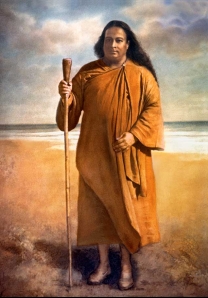
Paramhansa Yogananda: India’s first high-profile NRI was a yoga guru
At a time of the Pravasi Bharatiya Divas meet in MP, The Federal remembers India's pioneering NRI, the highly accomplished Paramahansa Yogananda, who awed Americans a century ago with his expertise in Kriya yoga

When he set sail to the US in 1920, no one would have even remotely thought that the young man would catapult as the first spiritual Non-Resident Indian. Paramhansa Yogananda not only earned that iconic status but became one of India’s first and most successful brand ambassadors.
In a short span of 32 years until his dramatic death in Los Angeles in 1952, Yogananda achieved cult status, teaching spirituality and initiating a whopping 100,000 Americans – blacks as well as whites – into yoga at a time when the ancient philosophy was practically unknown.
Yogananda’s achievements did not come easily. He operated in an era when communication was an arduous task and transporting oneself from one part of the sprawling United States to another involved energy and passion – which he had in abundance – as well as money, which he was always short of.
‘An exceptional human being’
American writer Philip Goldberg, who has studied the impact of India’s spiritual teachings on the West, calls Yogananda an exceptional human being who knew his own innate powers and his life’s purpose at an early phase.
Reaching the US was one thing, staying put and spreading the virtues of yoga needed massive dedication. His skin colour, long hair and turban invited scorn and occasional abuse on the streets. Christian missionaries were particularly opposed to him. According to Goldberg, Yogananda endured sneers, stone-throwing and name-calling, but he maintained his yogic dignity.
Also read: Members of diaspora have always been admirable Indian ambassadors: PM Modi
Yogananda toured the length and breadth of the US, wooing spiritually-hungry audiences. His following kept expanding, surprising newspapers and causing envy among those who did not approve of the way Yogananda merged Jesus into Hindu teachings.
He repeatedly pointed out the essential unity of all great scriptures, and he strove to bring together the West and East on a spiritual foundation.
Yogananda covered almost every major state and city in the US: New York, New Jersey, Colorado, Seattle, Oregon, San Diego, San Francisco, Portland, Oakland, Berkeley, Los Angeles, Pittsburgh, Detroit, Cleveland, Ohio… The halls where he lectured were packed with thousands; at times, many were forced to stand because there was no place to sit.
’20th century’s first superstar guru’
Within a few years, the Los Angeles Times dubbed him “the 20th century’s first superstar guru”.
Unlike Swami Vivekananda who preceded Yogananda to the US but returned to India, the latter stayed put in his bid to spread spirituality. He made his yoga teachings simpler for Westerners to understand. Goldberg noted that Yogananda “stalked God like Sherlock Holmes stalked criminals”. The American media dubbed him a “Hindu savant”, “seer”, “educator” and “psychologist”.
Also read: Indian Diaspora keeping identity of India alive wherever they are: Rajnath Singh
Yogananda was born into a middle-class family on January 5, 1893, in Gorakhpur as Mukunda Lal Ghosh. He was attracted to spirituality at a young age. At his guru Sri Yukeshwar Giri’s urging, he joined the Swami order and got his assumed name. Both the guru and his favourite disciple were students of Kriya Yoga.
Barring a single trip that he made to India in the early 1930s when he taught Kriya Yoga to Mahatma Gandhi, Paramhansa Yogananda lived in the US till 1952 preaching yoga, meditation, karma, reincarnation, mantras, and chakras to Americans.
His autobiography became a bestseller
The high point of his spiritual career was his mesmerizing book, Autobiography of a Yogi, which was published in the US in 1946 and immediately came to be recognized as one of the 10 best spiritual classics of the 20th century. It has sold millions of copies in more than 20 languages and remains a bestseller. In the spirit of a yogi who doesn’t boast, Yogananda made no mention in the autobiography of the immense sacrifices he made and the suffering he endured in the US.
What Yogananda achieved as India’s first spiritual NRI was as spectacular as the way he died.
On March 7, 1952, at a banquet held in the honour of India’s ambassador to the US at Biltmore Hotel in Los Angeles, Paramhansa Yogananda gave a speech, his final act, eulogizing spirituality and India and ending with: “I am proud that I was born in India… where the Ganges, woods, Himalayan caves, and men dream God.”
With those words, Yogananda slid to the floor with a beatific smile on his face. He had attained ‘samadhi’.
Several honours from the Indian government
The Indian government has thrice honoured Paramhansa Yogananda. It released a postage stamp in 1977. A second stamp came in 2017 marking 100 years of an ashram he set up in Ranchi. In 2019, a commemorative coin of Rs 125 denomination was issued to mark his 125th birth anniversary.
Also read: High-profile Indian diaspora group raises USD 600K for COVID-19 relief
“Here was a yogi who took the (yoga) message … and made it so acceptable for the whole world,” Finance Minister Nirmala Sitharaman said on an occasion. “India feels strongly about this great son of the universe who brought harmony to all our hearts and minds.”
In Indore, where the Indian Diaspora has now gathered, the Autobiography of a Yogi must be presented to each man and woman in attendance. It will be the perfect tribute to India’s first high-profile NRI whose contribution to the popularity yoga has achieved today largely remains unknown.


